HONDA PRELUDE 1990 Owners Manual
Manufacturer: HONDA, Model Year: 1990, Model line: PRELUDE, Model: HONDA PRELUDE 1990Pages: 143, PDF Size: 2.07 MB
Page 121 of 143
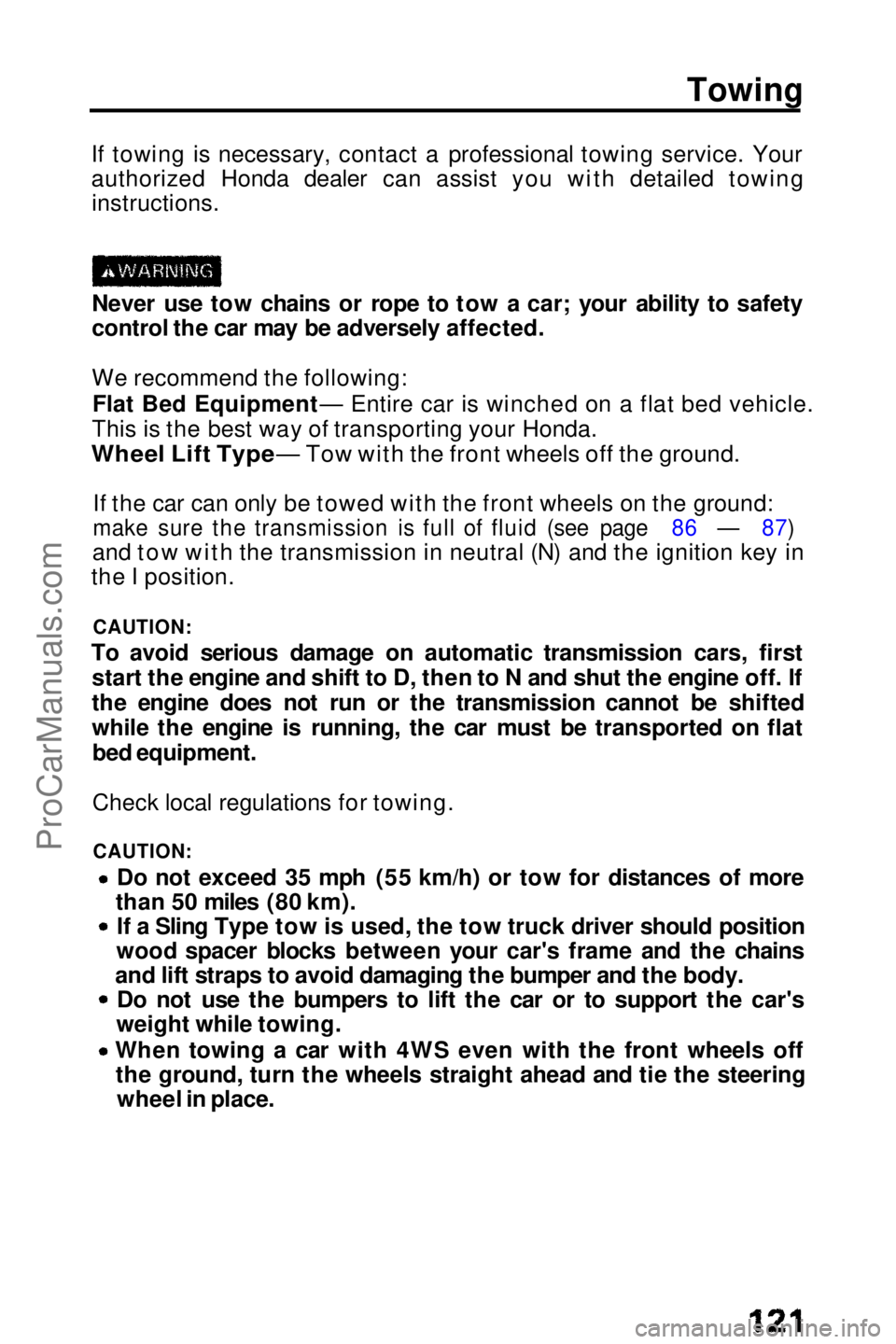
If towing is necessary, contact a professional towing service. Your
authorized Honda dealer can assist you with detailed towing
instructions.
Never use tow chains or rope to tow a car; your ability to safety
control the car may be adversely affected.
We recommend the following:
Flat Bed Equipment — Entire car is winched on a flat bed vehicle.
This is the best way of transporting your Honda.
Wheel Lift Type — Tow with the front wheels off the ground.
If the
car can only be towed with the front wheels on the ground:
make sure the transmission is full of fluid (see page 86 — 87)
and tow with the transmission in neutral (N) and the ignition key in
the I position.
CAUTION:
To avoid serious damage on automatic transmission cars, first start the engine and shift to D, then to N and shut the engine off. If
the engine does not run or the transmission cannot be shifted
while the engine is running, the car must be transported on flatbed equipment.
Check local regulations for towing.
CAUTION:
Do not exceed 35 mph (55 km/h) or tow for distances of more
than 50 miles (80 km). If a Sling Type tow is used, the tow truck driver should position
wood spacer blocks between your car's frame and the chains
and lift straps to avoid damaging the bumper and the body. Do not use the bumpers to lift the car or to support the car's
weight while towing.
When towing a car with 4WS even with the front wheels off the ground, turn the wheels straight ahead and tie the steering wheel in place. TowingProCarManuals.comMain Menu s t
Page 122 of 143

If Your Car Gets Stuck
If your car gets stuck in sand, mud, or snow, call a professional
towing service for assistance in getting your car out,
CAUTION:
Do not rev up the engine and allow the wheels to spin freely at
high speed. Severe transmission damage may result if the wheels are allowed to spin for more than a few seconds. DO NOT try to free a car with automatic transmission from
snow etc. by rocking the car alternately between forward and
reverse gears. Severe transmission damage may result from
shifting into gear with the wheels moving.ProCarManuals.comMain Menu s t
Page 123 of 143
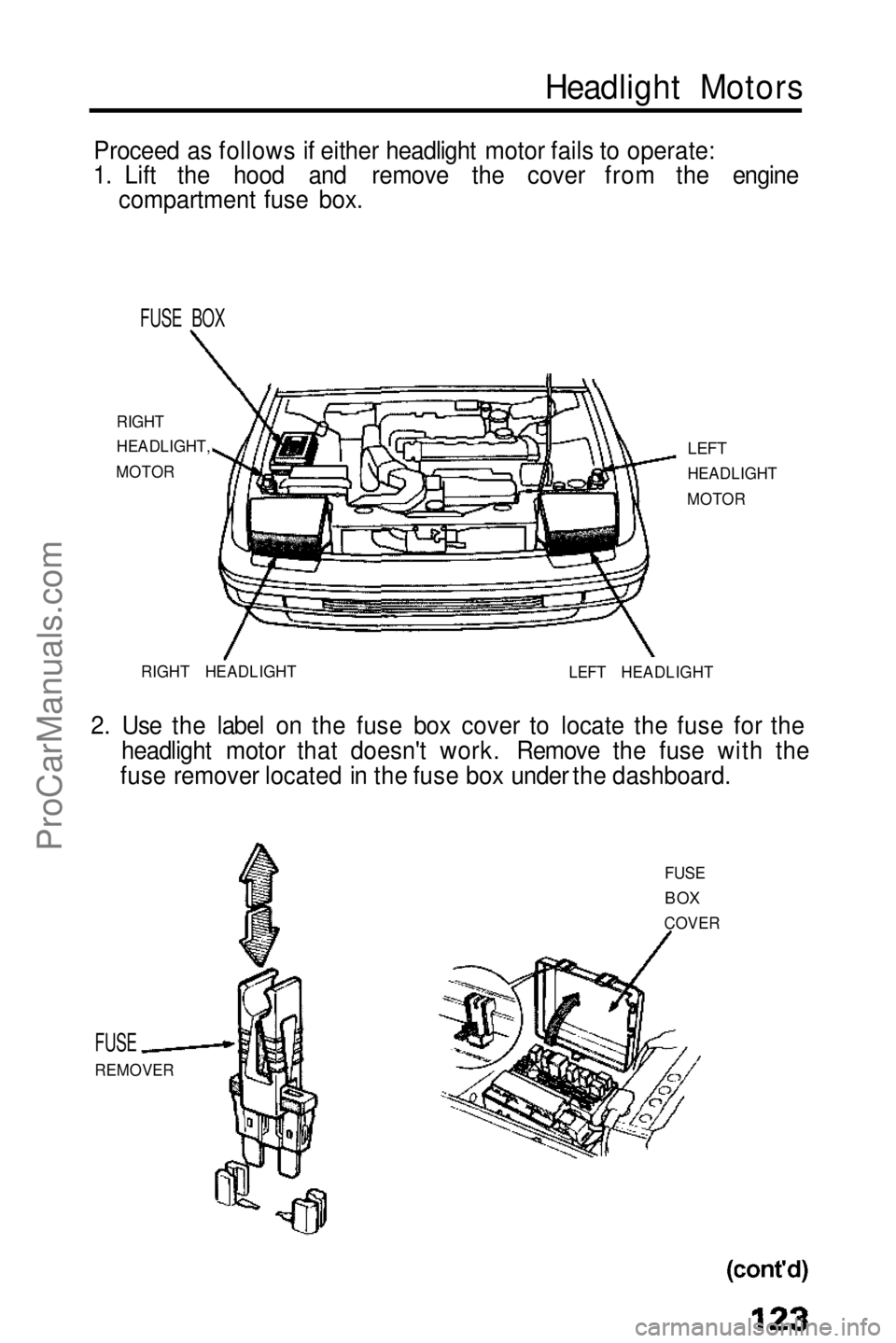
Headlight Motors
Proceed as follows if either headlight motor fails to operate:
1. Lift the hood and remove the cover from the engine compartment fuse box.
FUSE BOX
RIGHT
HEADLIGHT,
MOTOR
LEFT
HEADLIGHT
MOTOR
RIGHT HEADLIGHT LEFT HEADLIGHT
2. Use the label on the fuse box cover to locate the fuse for the headlight motor that doesn't work. Remove the fuse with the
fuse remover located in the fuse box under the dashboard.
FUSE
REMOVER FUSE
BOX
COVERProCarManuals.comMain Menu s t
Page 124 of 143
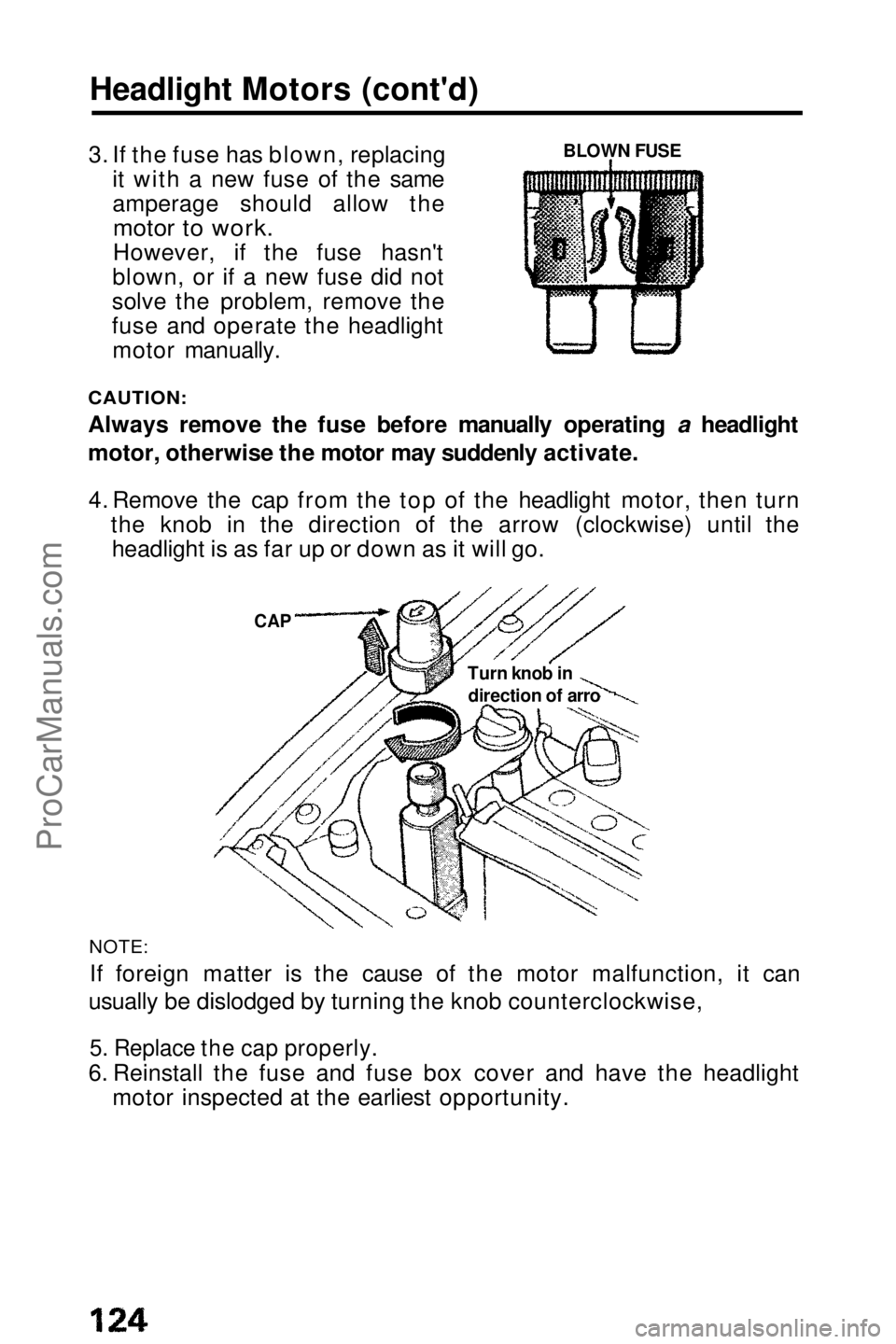
Headlight Motors (cont'd)
3. If the fuse has blown, replacing it with a new fuse of the same
amperage should allow the
motor to work.
However, if the fuse hasn't
blown, or if a new fuse did not
solve the problem, remove the
fuse and operate the headlight motor manually.
CAUTION:
Always remove the fuse before manually operating a headlight
motor, otherwise the motor may suddenly activate.
4. Remove the cap from the top of the headlight motor, then turn the knob in the direction of the arrow (clockwise) until theheadlight is as far up or down as it will go.
NOTE:
If foreign matter is the cause of the motor malfunction, it can
usually be dislodged by turning the knob counterclockwise,
5. Replace the cap properly.
6. Reinstall the fuse and fuse box cover and have the headlight motor inspected at the earliest opportunity. BLOWN FUSE
CAP
Turn knob indirection of arroProCarManuals.comMain Menu s t
Page 125 of 143
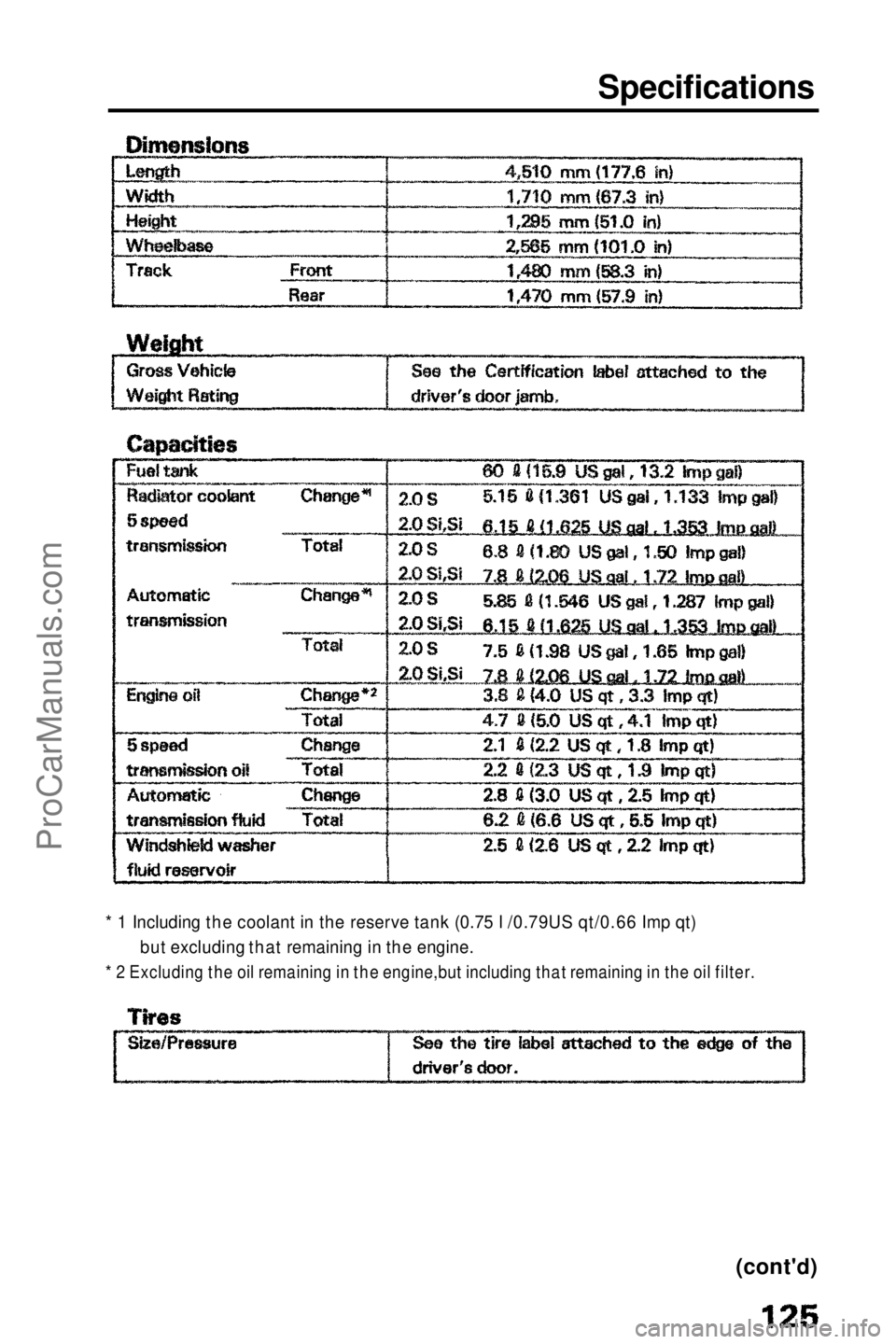
Specifications
* 1 Including the coolant in the reserve tank (0.75 l /0.79US qt/0.66 Imp qt) but excluding that remaining in the engine.
* 2 Excluding the oil remaining in the engine,but including that remaining in the oil filter.
(cont'd)ProCarManuals.comMain Menu t s
Page 126 of 143
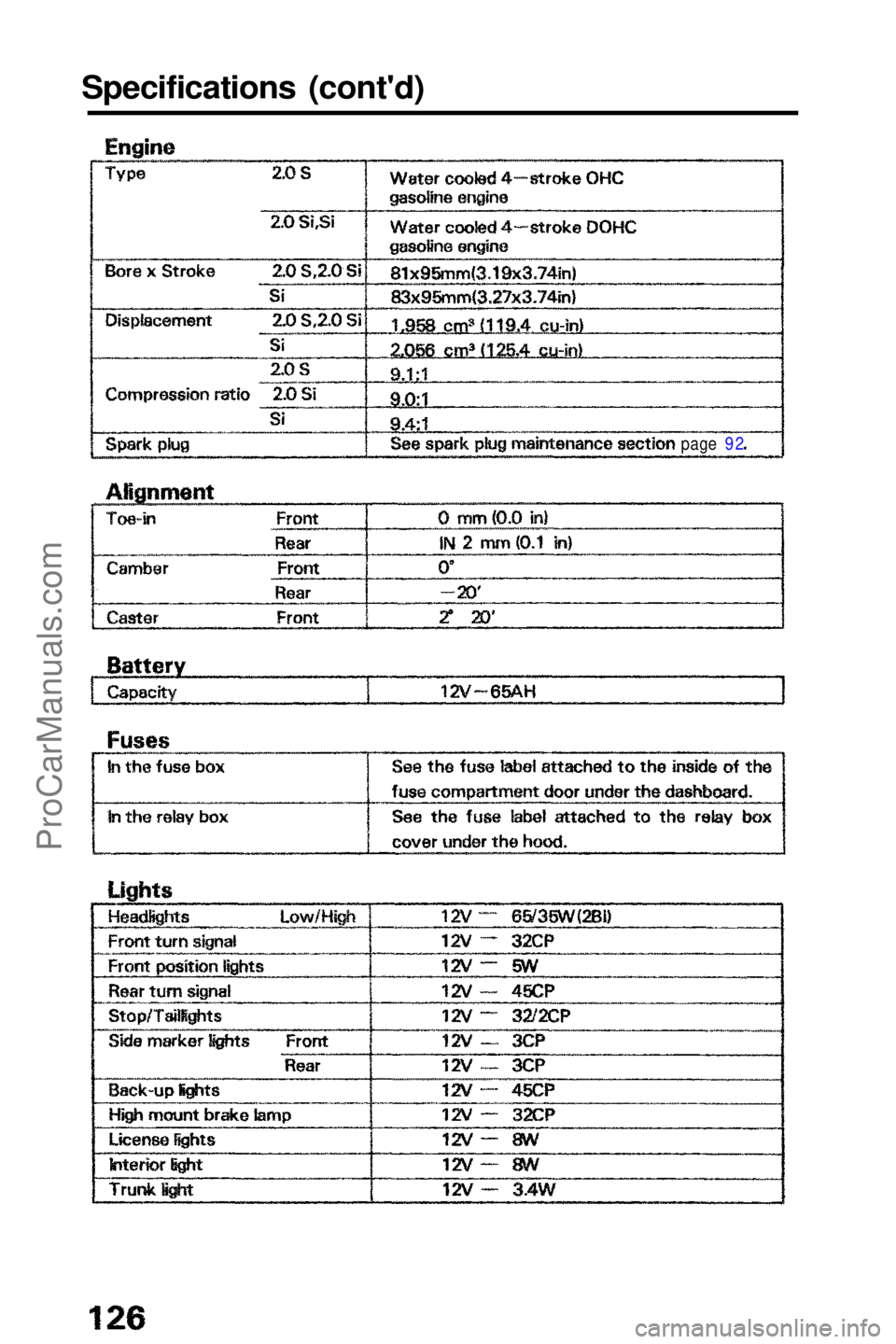
Specifications (cont'd)
page 92ProCarManuals.comMain Menu t s
Page 127 of 143
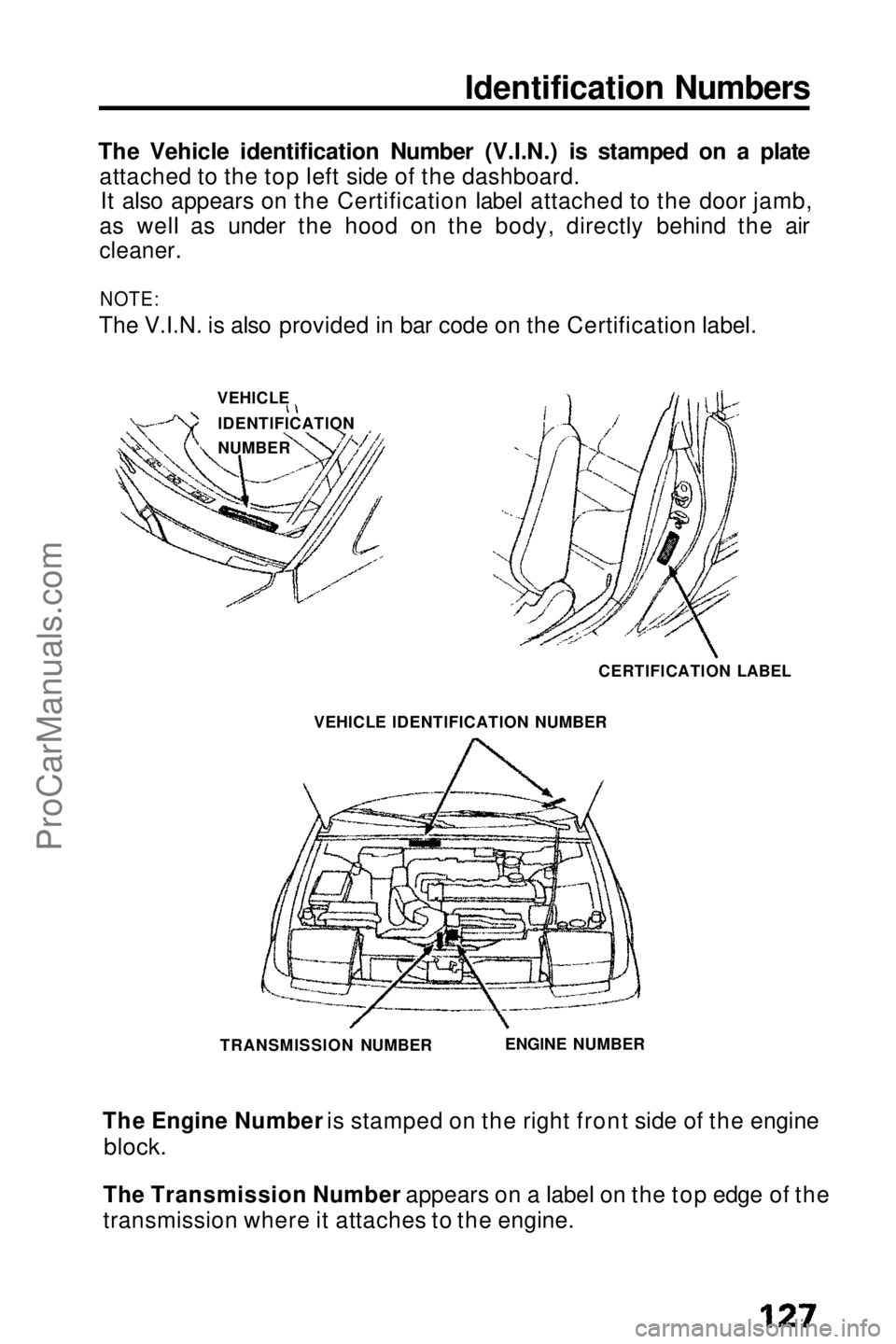
Identification Numbers
The Vehicle identification Number (V.I.N.) is stamped on a plate attached to the top left side of the dashboard.It also appears on the Certification label attached to the door jamb,
as well as under the hood on the body, directly behind the air
cleaner.
NOTE:
The V.I.N. is also provided in bar code on the Certification label.
VEHICLE IDENTIFICATION NUMBER
TRANSMISSION NUMBER
ENGINE NUMBERThe Engine Number is stamped on the right front side of the engine
block.
The Transmission Number appears on a label on the top edge of the
transmission where
it attaches to the engine.CERTIFICATION LABEL
VEHICLE
IDENTIFICATION
NUMBERProCarManuals.comMain Menu t s
Page 128 of 143
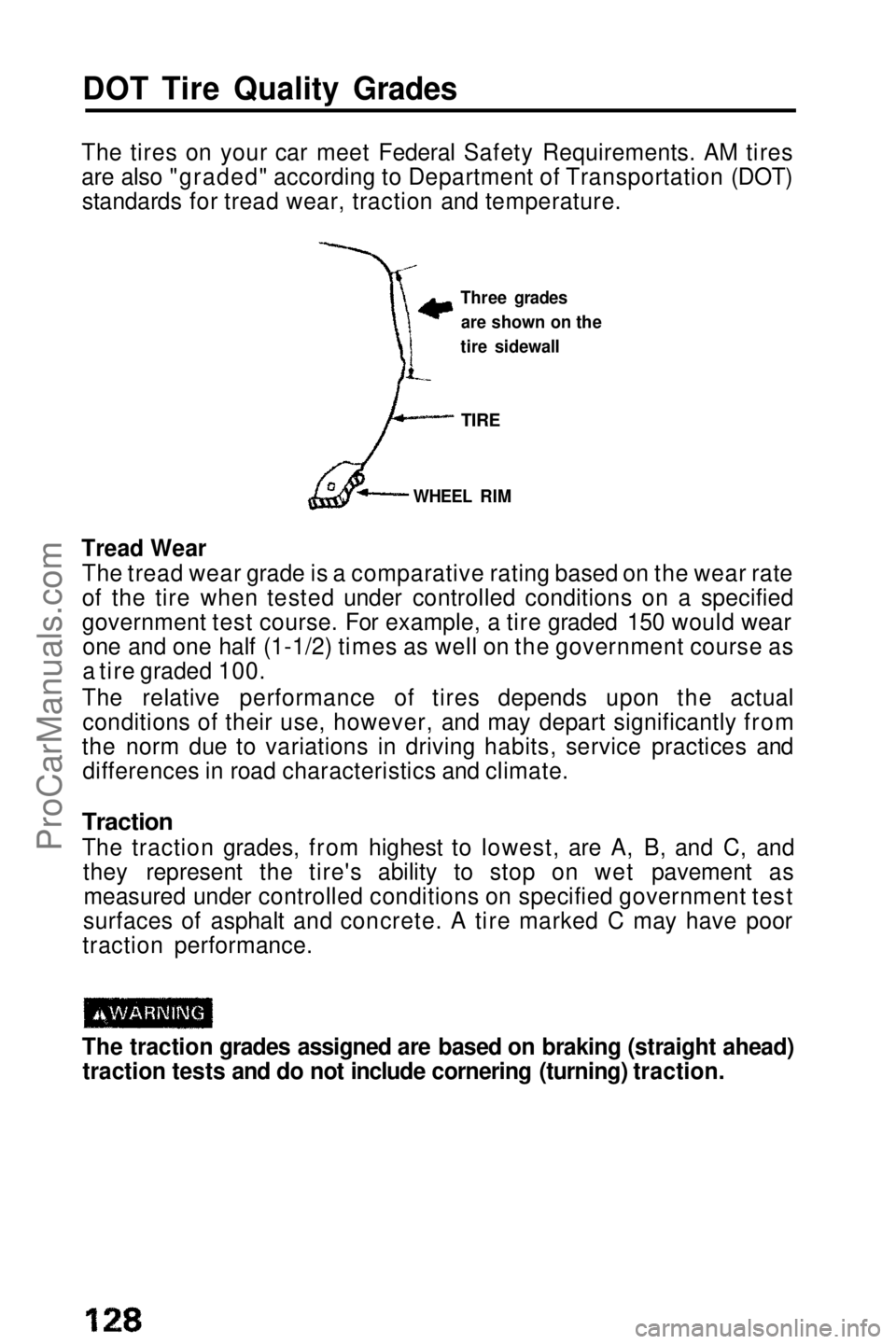
DOT Tire Quality Grades
The tires on your car meet Federal Safety Requirements. AM tires
are also "graded" according to Department of Transportation (DOT) standards for tread wear, traction and temperature.
Three gradesare shown on the
tire sidewall
TIRE
WHEEL RIM
Tread Wear The tread wear grade is a comparative rating based on the wear rate
of the tire when tested under controlled conditions on a specified
government test course. For example, a tire graded 150 would wearone and one half (1-1/2) times as well on the government course as
a tire graded 100.
The relative performance of tires depends upon the actual conditions of their use, however, and may depart significantly from
the norm due to variations in driving habits, service practices and differences in road characteristics and climate.
Traction
The traction grades, from highest to lowest, are A, B, and C, and they represent the tire's ability to stop on wet pavement asmeasured under controlled conditions on specified government test
surfaces of asphalt and concrete. A tire marked C may have poor
traction performance.
The traction grades assigned are based on braking (straight ahead) traction tests and do not include cornering (turning) traction.ProCarManuals.comMain Menu t s
Page 129 of 143

Temperature
The temperature grades are A (the highest), B and C representing
the tire's resistance to the generation of heat and its ability to
dissipate heat when tested under controlled conditions on aspecified indoor laboratory test wheel. Sustained high temperature
can cause the material of the tire to degenerate and reduce tire life, and excessive temperature can lead to sudden tire failure. The grade
C corresponds to a level of performance which all passenger car
tires must meet under the Federal Motor Vehicle Safety Standard No. 109. Grades B and A represent higher levels of performance on
the laboratory test wheel than the minimum required by law.
The tire temperature grade is established for a tire that is properly
inflated and not overloaded. Excessive speed, underinflation, or
excessive loading, either separately or in combination, can cause
heat buildup and possible tire failure.ProCarManuals.comMain Menu t s
Page 130 of 143

Emission Controls
Sources of Emissions
The combustion process produces carbon monoxide, oxides of nitrogen and hydrocarbons. The evaporation of fuel in the fuel tank
also produces hydrocarbons. Control of oxides of nitrogen and
hydrocarbons is very important since, under certain conditions,
when subjected to sunlight, they react to form photochemical smog. Carbon monoxide does not react to form smog, but it is toxic.
Honda Motor Co., Ltd. has developed a number of systems which
are highly effective in reducing carbon monoxide, oxides of nitrogen
and hydrocarbons.
The Clean Air Act
The Clean Air Act requires all vehicle manufacturers to explain in writing, the operation and maintenance of their emission control
systems.
Maintenance instructions are included on pages 76—81 ; the
operation of each system is explained on the following.
Replacement Parts
The emission control systems on your new Honda were designed, built and certified to conform with the Federal regulations
implementing the Clean Air Act. Honda recommends only the use of
new, genuine Honda parts or their equivalent. The use of other
replacement parts which are not of equivalent quality may impair
the effectiveness of your car's emission control systems.
Crankcase Emission Control System
To prevent crankcase emissions, your car is equipped with a Positive Crankcase Ventilation (PCV) System which routes blowby
gases from the crankcase, through the PCV valve and intake manifold, into the combustion chamber.ProCarManuals.comMain Menu t s